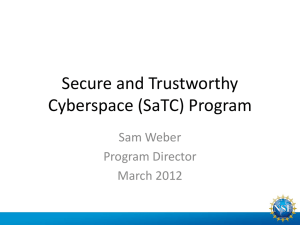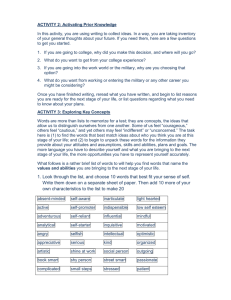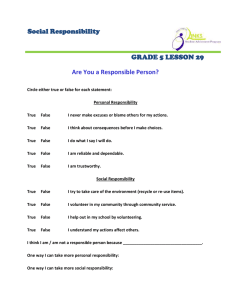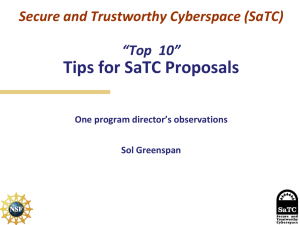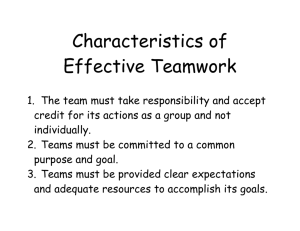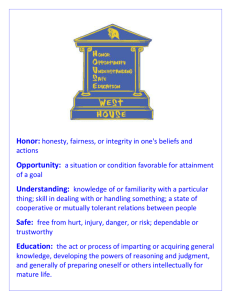Trustworthy Computing and Transition to Practice Secure and Trustworthy Cyberspace (SaTC)
advertisement
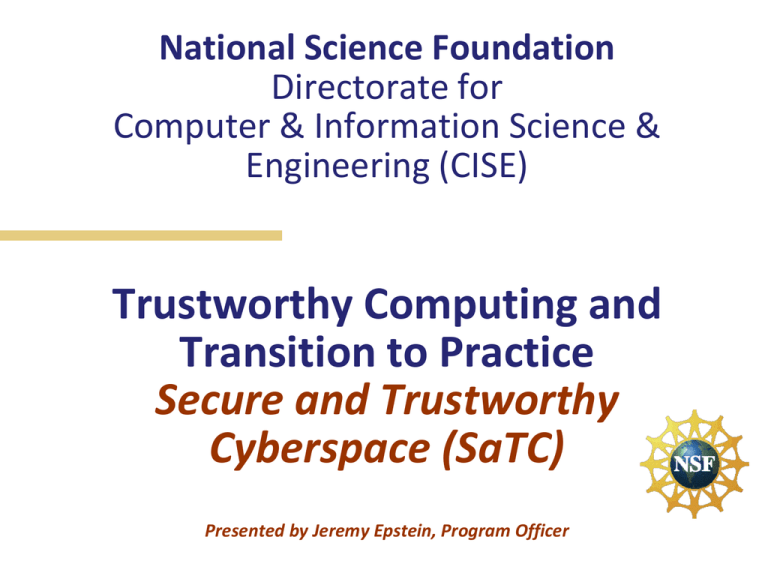
National Science Foundation Directorate for Computer & Information Science & Engineering (CISE) Trustworthy Computing and Transition to Practice Secure and Trustworthy Cyberspace (SaTC) Presented by Jeremy Epstein, Program Officer SaTC Goals and Perspectives • Goal: To protect cyber-systems (including host machines, the internet and other cyber-infrastructure) from malicious behaviour, while preserving privacy and promoting usability • SaTC emphasizes different approaches and research communities by introducing perspectives – Trustworthy Computing (TWC) – Social, Behavioral & Economic (SBE) – Transition to Practice (TTP) – Cybersecurity Education (EDU) 2 SaTC Combinations 3 Trustworthy Computing Systems Perspective 4 Trustworthy Computing Systems Perspective • Roughly corresponds to former Trustworthy Computing Program • Supports designing, building or operating cyber-infrastructure that resists malicious attackers – Includes security, privacy and accountability concerns • Supports approaches from theoretical to experimental to humancentric • Theories, models, algorithms, methods, architectures, languages, tools, systems and evaluation frameworks • Studies of tradeoffs among security, privacy, usability • Methods to assess, reason about and predict system trustworthiness • Methods to increase attacker cost, enable tailored security environments 5 Does my area fit? • Look on www.nsf.gov/awardsearch for what we’ve funded already! 6 FY12 TWC Actual Funding Areas (83 proposals / 56 projects total) • Medical device security • Network security (BGP, IDS) • Browser security • Software security • Anonymity • Cybereconomics • Mobile device security & privacy • Censorship evasion • Cloud security • Security data collection & analysis • Hardware security • Social network security • Smart grid security • Data privacy • Biometrics 7 • Security usability National Strategy Areas Where We’d Like To See More Proposals • Underrepresented – Moving Target – Tailored Trustworthy Spaces – Science of Security • Well represented in – Designed-In Security – Cybereconomics 8 Common Mistakes in TWC • Lack of a clear threat model – a solution without knowing the problem you’re trying to solve! • Insufficient comparison to other research • In some areas, insufficient comparison to commercial products 9 Transition To Practice Option and Perspective 10 Transition Option vs. Perspective Transition Perspective 11 Transition Option Transition Perspective • Take existing research, extend it, and focus on transitioning to practice – Commercial – State, local, Federal government • Release as open source • “Applied research, development, prototyping, testing, and experimental deployment” 12 TTP Perspective Requirements The expected impact on the deployed environment described in the proposal. The extent to which the value of the proposed cybersecurity research and development is described in the context of a needed capability required by science and engineering, and potential impact across a broader segment of the NSF community. The feasibility, utility, and interoperability of the capability in its proposed operational role. A project plan that addresses in its goals and milestones the demonstration and evaluation of a working system in the target environment. Tangible metrics described to evaluate the success of the capabilities developed, and the steps necessary to take the 13 system from prototype status to production use. Transition Option • Transition option is an optional supplemental part to small, medium, and Frontier proposals going into TWC and/or SBE perspectives • Description of phase activities in supplementary documents – NOT IN THE BASE DOCUMENT • Transition option – Will NOT factor into the primary proposal review – Will NOT factor into ranking of proposal in the review panel 14 TTP Option Requirements The expected impact on the deployed environment described in the proposal supplemental document. The extent to which the value of the proposed cybersecurity research and development is described in the context of a needed capability required by science and engineering, and potential impact across a broader segment of the NSF community. The feasibility, utility, and interoperability of the capability in its proposed operational role. An option project plan that addresses in its goals and milestones the demonstration and evaluation of a working system in the target environment. Tangible metrics described to evaluate the success of the capabilities developed, and the steps necessary to take the system from prototype status to production use. The appropriateness of the budget for the option. The supplemental document should explain how the additional budget will be used to execute the option. 15 Which One to Use? • If existing research results to be transitioned, then use TTP perspective • If new research which you plan to transition, then use TTP option • May not include both in the same proposal! • Common mistakes for option: – Option must include separate document describing the option activities, and must not be described in the base proposal – Budget for option must not be included in the proposal budget – Word “Option” must be in 16 the proposal title Advertisement! 17 http://www.satc-cybercafe.net/ National Science Foundation Directorate for Computer & Information Science & Engineering (CISE) Trustworthy Computing and Transition to Practice Secure and Trustworthy Cyberspace (SaTC) Presented by Jeremy Epstein, Program Officer
